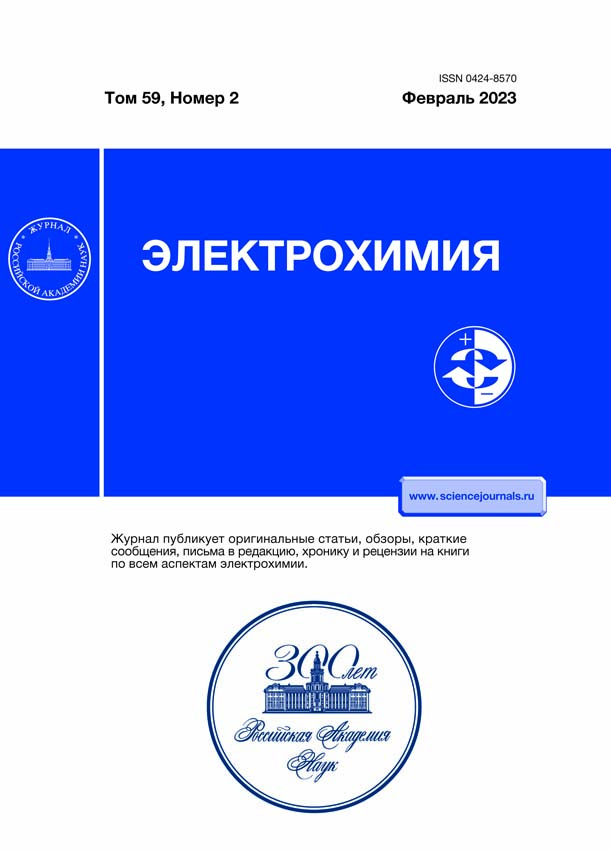Effect of Ga3+ and In3+ Ions on the Anodic Dissolution of Aluminum in KOH Ethanol Solutions
- Autores: Rybalka K.V.1, Beketaeva L.A.1
-
Afiliações:
- Frumkin Institute of Physical Chemistry and Electrochemistry, Russian Academy of Sciences
- Edição: Volume 59, Nº 2 (2023)
- Páginas: 111-116
- Seção: Articles
- URL: https://cardiosomatics.ru/0424-8570/article/view/671132
- DOI: https://doi.org/10.31857/S0424857023020093
- EDN: https://elibrary.ru/NGEFCD
- ID: 671132
Citar
Texto integral
Resumo
The anodic dissolution of aluminum in the KOH ethanol solutions is considered. It is shown that an addition of gallium and indium compounds to the 2 M KOH solution in 96% ethanol leads to an abrupt increase in the anodic dissolution current of aluminum near the open-circuit potential and its shift by 300 mV toward negative values. The discharge galvanostatic curves in the solutions with the additives of gallium and indium compounds contain a flat discharge plateau at the current densities up to 4 mA/cm2. The hydrogen evolution rate in a number of KOH ethanol solutions is measured.
Sobre autores
K. Rybalka
Frumkin Institute of Physical Chemistry and Electrochemistry, Russian Academy of Sciences
Email: mamaison2000@yandex.ru
Moscow, 119071 Russia
L. Beketaeva
Frumkin Institute of Physical Chemistry and Electrochemistry, Russian Academy of Sciences
Autor responsável pela correspondência
Email: mamaison2000@yandex.ru
Moscow, 119071 Russia
Bibliografia
- Matsuda, Y., Ouchi, Y., and Tamura, H., Anodic polarization of aluminium in organic electrolytes, J. Appl. Electrochem., 1974, vol. 4, p. 53.
- Гонтмахер, Н.М., Григорьев, В.П., Нечаева, О.Н., Беркман, Е.А., Гутерман, В.Е., Петрова, Г.М. Растворение Al и сплава Al–Mg–Hg в органических и водноорганических средах. Электрохимия. 1984. Т. 20. С. 80. [Gontmakher, N.M., Grigoriev, V.P., Nechaeva, O.N., Berkman, E.A., Guterman, V.E., and Petrova, G.M., Dissolution of aluminum and Al–Mg–Hg alloys in organic and aqueous-organic solvents, Sov. Electrochem., 1984, vol. 20, p. 76.]
- Скундин, А.М., Осетрова, Н.В. Использование алюминия в низкотемпературных источниках тока. Электрохим. кинетика. 2005. Т. 5. № 1 С. 3. [Skundin, A.M., and Osetrova, N.V., The use of aluminum in low-temperature current sources, Electrochemical kinetics, 2005, vol. 5, no. 1, p. 3.]
- Bai, L. and Conway, B.E., Complex behavior of Al dissolution in non-aqueous medium as revealed by impedance spectroscopy, J. Electrochem. Soc., 1990, vol. 137, no. 12, p. 3737.
- Bai, L. and Conway, B.E., Role of indium in promoting anodic dissolution of Al-In alloys in non-aqueous electrolyte, J. Appl. Electrochem., 1992, vol. 22, p.131.
- Rybalka, K.V. and Beketaeva, L.A., Anodic dissolution of aluminium in nonaqueous electrolytes, J. Power Sources, 1993, vol. 42, p. 377.
- Shao, H.B., Wang, J.M., Wang, X.Y., Zhang, J.O., and Cao, C.N., Anodic dissolution of aluminum in KOH ethanol solutions, Electrochem. Comm., 2004, vol. 6, p. 6.
- Burri, G., Luedi, W., and Haas, O., Electrochemical properties of aluminum in weakly acidic sodium chloride solutions, Part I. Influence of the electrolyte additives In3+, and Zn2+, J. Electrochem. Soc., 1989, vol. 136, no. 8, p. 2167.
- Equey, J.F., Müller, S., Desilvestro, J., and Haas, O., Electrochemical properties of aluminum in weakly acidic sodium chloride solutions. II. Influence of electrolyte additives Hg2+, In3+, Ga3+ and Sn3+, J. Electrochem. Soc., 1992, vol. 139, no. 6, p. 1499.
- Levitin, G., Tel-Vered, R., Yarnitzky, C., and Licht, S., Organic solvents for anodic aluminum electrochemistry, Rev. Anal. Chem., 1999, vol. 18, p. 269.
- Licht, S., Tel-Vered, R., Levitin, G., and Yarnitzky, C., Solution activators of aluminum electrochemistry in organic media, J. Electrochem. Soc., 2000, vol. 147, p. 496.
- Tel-Vered, R., Levitin, G., Yarnitzky, C., and Licht, S., Analytical determination of In activation of aluminum anodes in the organic phase, Rev. Anal. Chem., 1999, vol.18, no. 5, p. 249.
- Licht, S., Levitin, G., Tel-Vered, R., and Yarnitzky, C., The effect of water on the anodic dissolution of aluminum in non-aqueous electrolytes, Electrochem. Commun., 2000, vol. 2, p. 329.
- Levitin, G., Tel-Vered, R., Yarnitzky, C., and Licht, S., Analytical determination of water effects on the anodic dissolution of aluminum in nonaqueous electrolytes, Rev. Anal. Chem., 2000, vol. 19, p. 235.
- Licht, S., Levitin, G., Yarnitzky, C., and Tel-Vered, R., Organic phase for aluminum batteries, Electrochemical and solid-state letters, 1999, vol. 2, p. 262.
- Despic, A. and Parkhutik, V.P., Electrochemistry of Aluminum in Aqueous Solutions and Physics of its Anodic Oxide, in Modern Aspects of Electrochemistry. Conway, B.E., Bockris, J., O’M., and White, R.E., Eds, N.Y.: Plenum Press, 1991, vol. 20, p. 401.
- Breslin, C.B. and Carroll, W.M., The Electrochemical behavior of aluminum activated by Gallium in Aqueous Electrolytes, Corros. Sci., 1992, vol. 33, p. 1735.
Arquivos suplementares

















